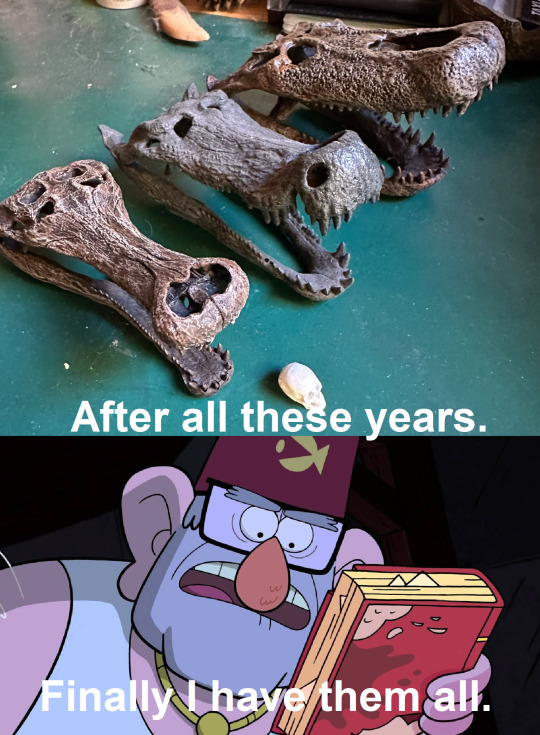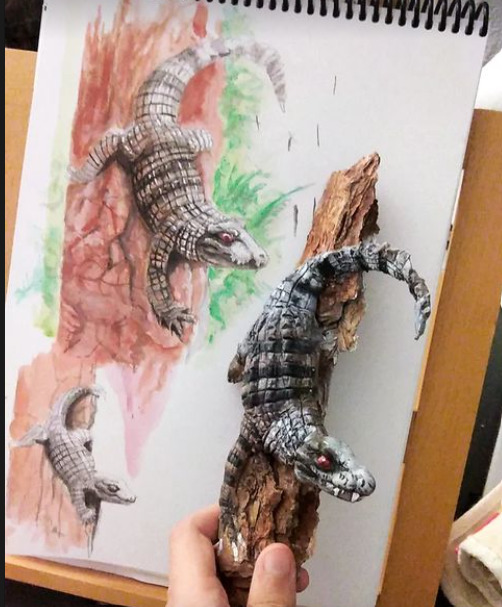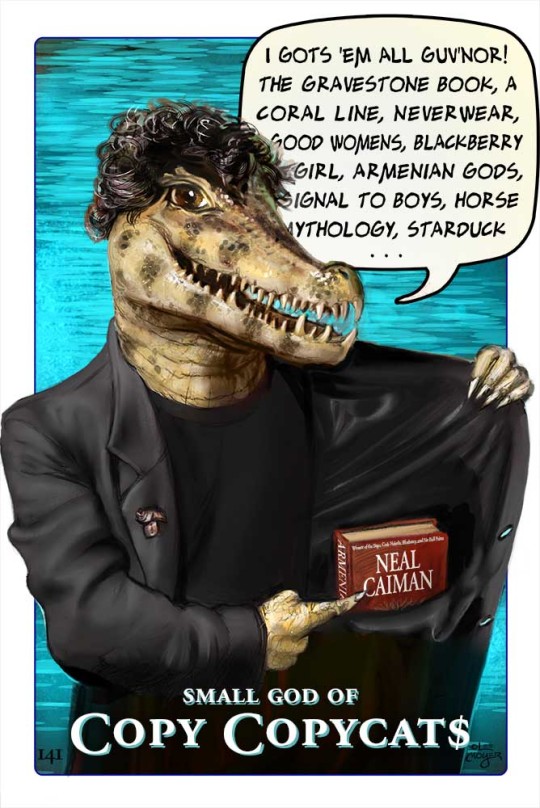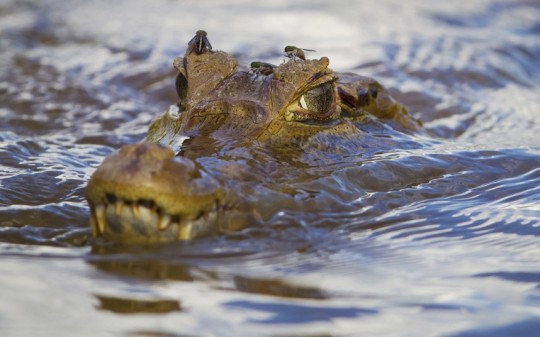#caimaninae
Text

Finally got THE BIG THREE. The skull models of Sarcosuchus, Deinosuchus and Purussaurus all made by Brennan Ruadhrí of scaledbeast.com. I can highly recommend them, they are available at different scales (these are the smallest) both with open and closed mouths. And for those not into crocs (well first of all shame on you) there's also dinosaurs, pterosaurs and other prehistoric animals available.
#scaledbeast#sarcosuchus#purussaurus#deinosuchus#croc#crocodilia#crocodylomorpha#models#skull#croctober#pholidosauridae#caiman#caimaninae#alligatoroidea#palaeoblr#paleontology#prehistory
595 notes
·
View notes
Text
All right Monty lovers, I hope this suffices! A bit shorter than TLT, but hopefully still good enough.
28 notes
·
View notes
Text
A speculative arboreal crocodylian

A year ago I began my research on the Mekosuchians, especially around the genus Mekosuchus and my already very strong skepticism at that time about the claims that they were tree-dwelling crocodiles (Something extremely improbable and which I may comment on another occasion. For now you can read in depth about Mekosuchus in this post by Armin).
At that point I wondered ; what would an arboreal crocodile really look like if it existed?
I decided that it would be a derived member of the subfamily Caimaninae, specifically belonging to the Jacarea clade (which includes all species of the genus Caiman and Melanosuchus).
The body has evolved in a convergentely with squamates such as Varanus salvator, being thinner and more elongated than that of any other crocodylian, following the same process the tail : Once the motor that propelled it underwater, is now becoming something similar to a whip that allows it to maintain balance on the branches, losing the characteristic single and double caudal crest whorls, to the point of almost disappearing.
The dorsal osteoderms are shrinking, but are still visible and play an important role in the ecology of the animal, helping it to thermoregulate.
The limbs have been considerably widened and strengthened, an adaptation very visible in the metatarsals of the hind legs, which, together with the sharp, curved claws they have developed, help the animal to cling effectively to trees.
The skull is the most distinctive part of all, as it has not only become shorter and more robust as a whole (Males have even developed an anteorbital crest similar to that of some members of the genus Crocodylus such as C. acutus or the extinct C. checchiai ; very likely some kind of sexual dimorphism), but it is developing unique characteristics such as binocular vision, zyphodont dentition and laterodorsally positioned nostrils, all of these attributes usually associated with terrestrial hunters (although there is not a necessary relationship in all cases), thus moving away from the semi-aquatic lifestyle.
Despite this, these crocodiles are still dependent on water to a certain extent, always inhabiting the forests near the rivers and being able to swim perfectly well if necessary, just like the extant iguanas and monitor lizards.
If I had to add some kind of worldbuilding that allows the existence of this animal, it would probably be located millions of years in the future : After a cataclysmic event related to climate change, South America has suffered a process of desertification in which large bodies of water have dried up, forcing the very abundant babas (Caiman crocodilus) to move into the remaining forests and jungles, adapting to a more terrestrial lifestyle. As an isolated population of these caimans chose the birds and monkeys as their preferred prey, they would gradually follow them to the treetops.
After a few more million years, the land has recovered, and large rivers and lakes are once again flooding South America, favoring the emergence of large tropical jungles again, opening a new world for these tree-dwelling caimans. Will they manage to adapt to the new climatic conditions or will they become extinct as a consequence of this and other factors such as the emergence of new species of placental predators that threaten to occupy their niche? Well, that is uncertain.
The illustration was made in gouache and watercolors during September 2022 . I scupted a small-basic figure made in clay to in order to facilitate the understanding of the lights and shadows.
Here are some pictures of the process:


#animals#crocodiles#reptiles#zoology#crocodilians#paleoart#art#nature#speculative biology#speculative evolution#speculative zoology
230 notes
·
View notes
Photo

[image description: An Alligatorid of the Caimaninae family wears a black t-shirt and an unconvincing black toupee. He smiles toothily and points to a red book – ‘Armenian Gods’, Winner of the Yugo, Crab Nebula, Blueberry, and No Bell Prizes – inside the breast pocket of his black jacket. Neal’s Sales Pitch appears in a big word balloon. Text reads, “I gots ‘em all guv’nor! The Gravestone Book, A Coral Line, Neverwear, Good Womens, Blackberry Girl, Armenian Gods, Signal to Boys, Horse Mythology, Starduck… 141, Neal Caiman ~ Small God of Copy Copycats”]
• • • • •
Here is a fact about humanity that humanity as a whole often tries to reject: originality is not the holy grail. There is no special award for being the first one to have an idea, no magical “you got there first, good show” prize for being the person to pioneer a new shape of story. Humans are magpies, one and all. They see, they steal, they polish and rearrange, building bowerbird palaces of bits and pieces, and the most enduring stories have always been made from the gutted remains of a thousand things that came before.
That isn’t to say that theft is an acceptable means of creative expression. The best are patchwork artisans, not highwaymen: they do not steal, but they allow themselves to be inspired by the stories already all around them, the fairy tales and the folklore, the local legends and the family rumors and the lies and the lies and the lies. It doesn’t matter, to a storyteller, whether the seed they plant is false or true; the story that sprouts from it will be both things at once, patently untrue, and yet filled with a core of absolute honesty. Neal is not a thief of dreams.
He is, however, a guide to all the many roads that you might potentially walk to find your own store of seeds.
He will walk with you through fairy tale forests and down dark folkloric lanes, guide you through the tangled briars of poetry and escort you into the gated halls of history. The seeds you plant may, in their first sprouting, resemble his own, but with proper care and nurturing, they will bloom into something altogether beautiful and different, and there will be none more eager to applaud you when you appear at your first Fiction and Floral Show than the scaly king of seams, who sees all the places you have stitched old stories together to come up with something entirely your own.
Don’t worry so much about being the first.
Worry about being the best.
• • • • •
Join Lee Moyer (Icon) and Seanan McGuire (Story) Monday, Wednesday, and Friday for a guide to the many small deities who manage our modern world:
Tumblr: https://smallgodseries.tumblr.com
Twitter: https://twitter.com/smallgodseries
Instagram: https://instagram.com/smallgodseries/
Homepage: http://smallgodseries.com
420 notes
·
View notes
Photo

Head of the caiman and alligator. A caiman is an alligatorid belonging to the subfamily Caimaninae, one of two primary lineages within Alligatoridae, the other being alligators. Caimans inhabit Mexico, Central and South America from marshes and swamps to mangrove rivers and lakes. Caimans have scaly skin and live a fairly nocturnal existence.
45 notes
·
View notes
Photo

Caimaninae Crocodilia . This Image is available to own as one in a Limited Edition Series of Seven Original Format, A1* Signed and Numbered Alu Di-bond prints priced @ £333 Inc. uk mainland p&p . Framed & Mounted A3* Prints are also available @ £66 Inc. uk mainland p&p. International postage also available. . Please feel free to Dm me regarding print purchase, collaborations & commissions . #caiman #everglades #naturalworld #landscape #florida #naturallight #dynasties #wildlifephotography #ukphotographer #travel #travelphotography #reptiles #burnmyeye #bokeh_bliss #macro_vision #naturalhabitat #wildanimals #swamplands #creativeoptic #artofvisuals #macroandflora #lensculture #visualambassadors #parallels #macro_delight #agameoftones #planetearth #eclectic_shotz #ig_tones (at Florida Everglades National Park) https://www.instagram.com/p/Brhk_7XDAC7/?utm_source=ig_tumblr_share&igshid=a2l2q05r61z3
#caiman#everglades#naturalworld#landscape#florida#naturallight#dynasties#wildlifephotography#ukphotographer#travel#travelphotography#reptiles#burnmyeye#bokeh_bliss#macro_vision#naturalhabitat#wildanimals#swamplands#creativeoptic#artofvisuals#macroandflora#lensculture#visualambassadors#parallels#macro_delight#agameoftones#planetearth#eclectic_shotz#ig_tones
0 notes
Photo

Jacaré É uma denominação comum às espécies de crocodilianos da família Alligatoridae, sendo muito parecidos com os crocodilos, dos quais se distinguem pela cabeça mais curta e larga e pela presença de membranas interdigitais nos polegares das patas traseiras. Os jacarés, que são também chamados "aligátores" ou "caimões", diferenciam-se dos crocodilos ainda com relação à dentição, o quarto dente canino da mandíbula inferior encaixa num furo da mandíbula superior, enquanto que nos crocodilos sobressai para fora, quando têm a boca fechada. O tamanho de um jacaré pode variar de 1,2 metros (jacaré-anão) até 5,5 metros (jacaré-açu), podendo pesar de seis a seiscentos quilos. Os jacarés habitam as Américas, tendo desaparecido da Europa no Plioceno. [carece de fontes] Na América do Norte, ocorre, somente, o gênero Alligator. "Aligátor" e "caimão" são sinônimos de "jacaré". Etimologia O termo "jacaré" se origina do termo tupi îakaré. O termo "aligátor" se origina do termo inglês alligator, que provavelmente é uma forma anglicanizada do espanhol "el lagarto". Algumas variações antigas da grafia incluem "allagarta" e "alagarto". Já o termo "caimão" se origina do termo taino kaiman. Caimão é um nome comum a diversos jacarés americanos do gênero Caiman. Características Os jacarés se diferenciam dos crocodilos por possuírem uma cabeça mais curta e mais larga, com focinhos mais avantajados. Jacarés também ingerem plantas e frutas além de sua dieta normal de carne e peixe. O menor jacaré é o jacaré-anão, cujo comprimento varia entre 1,2 - 1,4 metros e pesa de 6 a 7 kg. O aligátor-americano tem um tamanho médio de 3 - 4,6 m, chegando até 5,3 m[8][9] e 626 kg. O tamanho médio do jacaré-açu é de 2,8 - 4,2 m, podendo ultrapassar os 5 m e 400 kg. Distribuição geográfica O aligátor-americano (Alligator mississippiensis) é uma espécie típica dos Estados Unidos. O aligátor-chinês (Alligator sinensis) é encontrado no leste da China, na região do rio Yangtzé. Os jacarés da subfamília Caimaninae são encontrados na América do Sul, porém o jacaretinga (Caiman crocodilus) também é encontrado na América Central e sul do México. https://www.instagram.com/p/BpmgnNvnF6Z/?utm_source=ig_tumblr_share&igshid=1af3i0nz20whj
0 notes
Photo

Lunch is on the way - grilled Caiman legs with bananas and vegetables...Yummy 🍖🍗🍔 A caiman is an alligatorid crocodilian belonging to the subfamily Caimaninae, one of two primary lineages within Alligatoridae, the other being alligators. . . . . #iquitos #nauta #amazon #markets #caiman #amazonadventures #everydayperu #igersperu #MadeinPeru #DescúbreteEnPerú #gotogether #mustvisit #over60traveler #mustsee #instagood #impressions #keepitwild #exploremore #goexplore #ourplanetdaily #discoverglobe #travelphoto #travellife #followmefaraway #traveladdict #roamtheplanet #photodocumentary #reportagespotlight (at Iquitos, Peru)
#keepitwild#igersperu#descúbreteenperú#ourplanetdaily#impressions#amazonadventures#everydayperu#traveladdict#reportagespotlight#followmefaraway#over60traveler#goexplore#roamtheplanet#madeinperu#mustsee#photodocumentary#nauta#markets#gotogether#exploremore#mustvisit#travelphoto#travellife#instagood#iquitos#discoverglobe#amazon#caiman
0 notes
Text
New Post has been published on Empalme Correas Transportadoras
New Post has been published on http://empalmecorreastransportadoras.com/eligen-comite-que-definira-proyectos-de-desarrollo-comunitario-en-caimanes/
Eligen comité que definirá proyectos de desarrollo comunitario en Caimanes
Tendrá como misión proponer las iniciativas que puedan ser financiados cada año por el Fondo de Desarrollo Comunitario, establecido en el acuerdo con Minera Los Pelambres.
Con el objetivo de proponer a los vecinos de Caimanes proyectos y programas que puedan ser financiados cada año por el Fondo de Desarrollo Comunitario, definido en el acuerdo con Minera Los Pelambres (2016), hace unos días se eligió a los integrantes de un comité ciudadano que estará encargado de gestionar propuestas de desarrollo para esta localidad.
La comisión -que se eligió en una asamblea general en la que participaron más de 70 personas- está conformada por siete integrantes voluntarios y por ocho organizaciones sociales, cada una con un representante. Su tarea será analizar las diferentes ideas propuestas, las que luego serán presentadas en asambleas abiertas para su aprobación.
Hace más de un mes se habían constituido comités similares en las localidades de El Rincón y El Pupío. De esta forma, informó la faena -propiedad de Antofagasta Minerals- avanza el cumplimiento de los acuerdos firmados en mayo de 2016, luego de casi una década de conflictos por la construcción del tranque de relaves El Mauro.
Juan Pablo García, subgerente de Asuntos Públicos de Minera Los Pelambres, destacó que a través de este Fondo de Desarrollo Comunitario son los propios vecinos quienes deben discutir y definir los proyectos que se van a impulsar. “Por eso, es fundamental el involucramiento de la gente, su compromiso, lo que además les permite resguardar sus costumbres y tradiciones”.
TESTIMONIOS DE LOS INTEGRANTES
Doris Tapia, representante del grupo folclórico Semillas Folkay, dijo que “me interesé en participar porque soy caimanina y, obviamente, me gustaría que mi pueblo saliera adelante, que tuviera muchas cosas que nosotros en realidad necesitamos. Y por eso quiero ser partícipe de ese progreso para la comunidad. Además, represento a un grupo folclórico, donde nos interesa mucho el tema de la cultura, el patrimonio y la identidad de este pueblo”.
Carlos Cortés, presidente del Comité de Agua Potable Rural de Caimanes, manifestó su satisfacción por intervenir en un proceso democrático y trasparente. “Yo creo que es eso lo que se persigue, que acá pueda participar la mayor cantidad de gente posible, que esto no esté vetado a un grupo de personas y que sea transparente, que la gente sepa lo que está sucediendo. Y obviamente que hoy la comisión se lleva una responsabilidad, porque debemos crear las instancias para poder llevar los requerimientos de la comunidad a esta asamblea, para su posterior votación y elegir los mejores proyectos para nuestra localidad”.
Por su parte, Juan Carlos Cepeda, presidente del Club de Huasos de Caimanes, hizo hincapié en que “lo más importante de todo esto es que están los fondos, por lo que aquí no vamos a soñar, aquí vamos a ejecutar proyectos, puesto que los fondos ya existen y debemos aprovecharlos”.
Source link
0 notes
Note
Hi! I found your Security Breach fics on AO3 and I am absolutely feral about Caimaninae Eros. Your Cajun Monty gives me life, and I eish there was more of him in the Fandom. I'm gonna go read your other fics now, and I hope you have an amazing day and keep up the marvelous work!
Oh! I'm so glad!! Thank you!!
I honestly felt like that story was probably my weakest out of my FNAF ones, so it's really surprising and genuinely sweet to hear people like it so much. It means a lot to me!
Thank you for your support of my works! 💚💚 I hope you have a lovely day too!!
3 notes
·
View notes
Photo

[image description: An Alligatorid of the Caimaninae family wears a black t-shirt and an unconvincing black toupee. He smiles toothily and points to a red book - ’Armenian Gods’, Winner of the Yugo, Crab Nebula, Blueberry, and No Bell Prizes - inside the breast pocket of his black jacket. Neal’s Sales Pitch appears in a big word balloon. Text reads, “I gots ‘em all guv’nor! The Gravestone Book, A Coral Line, Neverwear, Good Womens, Blackberry Girl, Armenian Gods, Signal to Boys, Horse Mythology, Starduck… 141, Neal Caiman ~ Small God of Copy Copycats”]
Here is a fact about humanity that humanity as a whole often tries to reject: originality is not the holy grail. There is no special award for being the first one to have an idea, no magical “you got there first, good show” prize for being the person to pioneer a new shape of story. Humans are magpies, one and all. They see, they steal, they polish and rearrange, building bowerbird palaces of bits and pieces, and the most enduring stories have always been made from the gutted remains of a thousand things that came before.
That isn’t to say that theft is an acceptable means of creative expression. The best are patchwork artisans, not highwaymen: they do not steal, but they allow themselves to be inspired by the stories already all around them, the fairy tales and the folklore, the local legends and the family rumors and the lies and the lies and the lies. It doesn’t matter, to a storyteller, whether the seed they plant is false or true; the story that sprouts from it will be both things at once, patently untrue, and yet filled with a core of absolute honesty. Neal is not a thief of dreams.
He is, however, a guide to all the many roads that you might potentially walk to find your own store of seeds.
He will walk with you through fairy tale forests and down dark folkloric lanes, guide you through the tangled briars of poetry and escort you into the gated halls of history. The seeds you plant may, in their first sprouting, resemble his own, but with proper care and nurturing, they will bloom into something altogether beautiful and different, and there will be none more eager to applaud you when you appear at your first Fiction and Floral Show than the scaly king of seams, who sees all the places you have stitched old stories together to come up with something entirely your own.
Don’t worry so much about being the first.
Worry about being the best.
......................
Artist Lee Moyer (13th Age, Cursed Court) and author Seanan McGuire (Middlegame, Every Heart a Doorway) have joined forces to bring you icons and stories of the small deities who manage our modern world, from the God of Social Distancing to the God of Finding a Parking Space.
Join in each week on Monday, Wednesday, and Friday for a guide to the many tiny divinities:
Tumblr: https://smallgodseries.tumblr.com/
Twitter: https://twitter.com/smallgodseries
Instagram: https://www.instagram.com/smallgodseries/
Homepage: http://www.smallgodseries.com/
380 notes
·
View notes
Photo

A white caiman, also known as spectacled caiman, swims in the Manu National Park in Peru’s southern Amazon region of Madre de Dios. This 1.8 million hectares reserve is the largest National Park in Peru and is the home of about 1000 birds species and 200 mammals species among other animals, as reptiles and amphibians, and has one of the highest levels of biodiversity of any park in the world, with more than 200 varieties of trees found in one hectare. Picture: REUTERS/Enrique Castro-Mendivil (via Pictures of the day: 29 July 2014 - Telegraph)
#Spectacled Caiman#White Caiman#Caiman crocodilus#Caiman#Caimaninae#Alligatoridae#Crocodilia#Crocodylomorpha#Sauropsida#crocodilian#Manu National Park#Peru
65 notes
·
View notes
